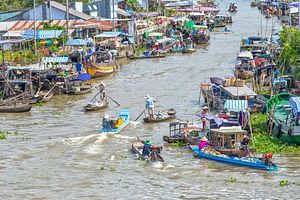The Mekong Delta is facing its worst drought in recent history, causing food and water shortages for over half a million people. The Chinese government has made headlines amidst the disaster for its decision to release water from upstream dams within China’s borders. Chinese ministry spokesman Lu Kang said in a news briefing that China “hopes it can be of help in alleviating the drought downstream.”
The water will be released until April 10 from the Jinghong dam, with the stated purpose to benefit Cambodia, Laos, Myanmar, Thailand, and Vietnam.
The Chinese ministry and media blame El Niño weather for the massive drought that has damaged 160,000 hectares (approximately 620 square miles) of rice in the Mekong Delta, left 600,000 people facing drinking water shortages, and resulted in losses of over $220 million. Vietnamese officials say El Nino is partly to blame, along with excessive construction of more than 10 hydropower dams on the upper stream of the river.
Little reporting on the issue has linked the drought to the dams, despite comments by Vietnamese officials. Mekong River conservationists, on the other hand, have been quick to draw connections. Niwat Roykaew, chair of Chiang Khong Conservation Group, believes the drought is caused by the six major man-made reservoirs on the upstream portion of the Mekong that lie within China’s borders.
“The Mekong River has a cycle. Rainwater in the monsoon season refreshes the snowpack and raises water levels. Snow melts in the dry season when the water levels are low. We don’t need more water from dams in the dry season. We need to sustain the natural circle that feeds the ecosystems and our livelihoods,” Roykaew said.
Drought in the Mekong Delta is nothing new. In 2010, a similar buzz was generated when the Mekong was facing its then worst-drought-in-history. China had just begun a campaign to counter the perception that its dams were hijacking the Mekong’s water as the river runs from the Tibetan Plateau to the South China Sea. At several news conferences, they made their case that the drought is purely a natural phenomenon.
China has good political reason to turn blame away from its dams. In an aggressive game of water diplomacy, China has gained enormous leverage over downstream countries by taking control over their primary water sources.
Geostrategist Brahma Chellaney describes how China could use its leverage to deter downstream countries from challenging its broader regional interests, citing that “smaller downriver countries in Southeast and Central Asia now use only coded language to express their concerns over Chinese dam building. For example, calling for transparency has become a way of referring obliquely to China, which smaller states are wary of mentioning by name.”
An analysis of Mekong water levels from 2014-2016 done by the Mekong River Commission shows water levels consistently increase from the beginning of February to the middle of March – a rainy season that is not usually a time of drought for the River delta. The analysis also shows that the Mekong water level started at 1,000 cubic meters per second this month, and within the past two weeks has shot up to 2,000 cubic meters per second. Under these conditions, operators of the upstream dams would need to release water to prevent overflowing or damage to the dams, regardless of downstream drought.
Another flaw in China’s water diplomacy is that more than 4,000 km lie between the Jinghong Dam, where the water will be released, and the Mekong Delta. Dr. To Van Truong, former Director of the Southern Irrigation Planning Institute, predicts that 3 percent to 4 percent of the water will arrive to the Delta itself.
Aside from leveraging control over downstream countries, China also has support for its own projects to gain. With its fingers spread across national boundaries, China is investing heavily in hydropower projects slated for construction along the lower Mekong mainstream. These projects threaten to greatly compound the impacts already being felt from upper Mekong dams within China. As the furthest downstream country, Vietnam, stands to bear a significant brunt of the impacts.
Blaming the drought on irregular weather, without acknowledging the impacts of either dams or climate change, is an act of intentional misinformation. When China began damming the Mekong and its upstream tributaries in the early 1990s, scientists predicted the kinds of droughts we’re seeing today. Several scientific studies now link extensive silt retention behind upstream dams to the drying up of Asia’s big deltas.
The fall in freshwater disgorged by rivers into the seas also increases water salinity in estuaries and rice paddies, endangering freshwater species and the livelihoods of rice farmers. According to the United Nations-sponsored Intergovernmental Panel on Climate Change, the Asian delta regions have become “much more vulnerable” to the effects of climate change and sea-level rise.
Meanwhile, major headlines such as “China to release water from dam to alleviate SE Asia drought” give the impression of China as a benevolent water savior to the region it has dammed. If China is concerned for the well-being of the quickly drying Mekong delta, and the millions of people and animal species that inhabit it, it should take lessons learned from these historical droughts into consideration before going ahead with current plans to build further dam cascades along the Mekong and its tributaries.
Margaret Zhou is an environmentalist working at the intersection of development, human rights, and environmental sustainability with NGOs working on dams and hydro power in Africa, Asia, and Latin America.
































